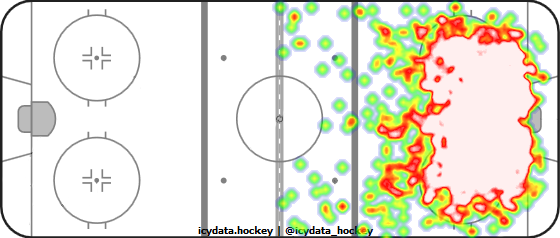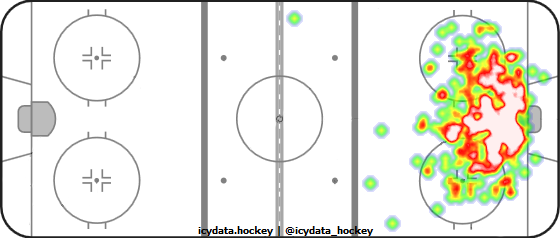Sorry. I don’t but I to expected goals. Seems very random to me. How do you come up with it?
Expected goals take into account the quality/location of each shot attempt based on the league-wide frequency of shots going in from similar locations and sequences.
Let's say goalie A faces 10 shots. All 10 are dump ins from the red line that happen to go on goal. Opposing goalie B faces 4 shots, all of which are 2 on 0s. Which goalie do you expect to allow more goals? If you are evaluating the team play in front of those two goalies, would you say that the team for goalie B did a better job than the team for goalie A since they are outshooting team B 10-4? Or would you say that the team with four 2-0s is outplaying the team that has just dumped the puck on net 10 times?
That is what expected goals are measuring: the quality/danger of the shot attempts. The actual formulas/calculations used are pretty damn complex and obviously the vast majority of shot attempts in hockey fall somewhere in between "dump on net" and "2 on 0."
Basic models only look at shot location. They don't factor in external factors and simply say "league-wide, a shot from this spot on the ice has X% chance of going in." They apply the percentage to every shot taken in a game to conclude that with an average performance by the shooters and goalie, you would expect Y goals to go in. For example, Team A takes 5 shots from an area with 20% goal rate, 10 shots from an area with a 10% goal rate and 20 shots from an area with a 5% goal rate. You would "expect" 3 goals to go in from those 35 shots, so the expected goals for that team would be 3.0 for that game. The formula would be (5 x .2) + (10 x .1) + (20 x .05) = 3 expected goals. If they had taken an additional shot from the area with a 10% goal rate, then the expected goals would be 3.1 for that game (5 x .2) + (11 x .1) + (20 x .05) = 3.1. Models like this are limited in value, but they paint a decent picture of teams that "force opponents to settle for bad shots from the perimeter."
Pretty much every model used today is substantially more complex than that. Modern goalies are good enough to stop the vast majority of unscreened shots when they are set and modern hockey offense is based around generating rebounds, forcing lateral movement, deflections, etc. A cross crease pass to the back door has a much higher chance of going in than a shot from the same location where the puck carrier walks the puck out from the corner and shoots on a goalie who is set on his post. To account for this, modern expected goal models use dozens of additional data points about what happened leading up to the shot attempt. In addition to weighting shots by location, they assign value to things that consistently increase the chance of shots going in. Shots taken directly after a zone entry are weighted as higher value because that corresponds to odd man rushes and breakaways. Rebound shots are weighted as higher value because they go in at a higher rate than non-rebound attempts. Shots immediately following a pass that crosses the "royal road" (essentially meaning a pass that forces a goalie to move side to side) are weighted higher. One-timers, deflections, screens, etc are considered.
The model is simply a way to use all of these data points to assign a numerical value to support what we already know from the eye test: That 2 on 0 has a much higher chance of going in than the dump in from the red line. The unscreened shot from the point probably isn't going in, but it has a much better chance of going in if it is deflected. Stuffing a puck into a goalie's pad when he's hugging the post probably isn't going in, but tapping a back door pass on net from the same spot probably is.
Expected goals are far from random. They define low, medium, and high danger chances based on tens of thousands of data sets that suggest how often pucks go in the net following a sequence of events. They are far from perfect and in small sample sizes are prone to being "off" because boiling down the cumulative actions of 10 players constantly moving within a 6,000 square foot offensive zone to 20 data points is imperfect. However, over large sample sizes, they are generally very good at determining the quality of chances teams are getting and giving up because they are based purely on averages. Teams that are constantly allowing a greater number of odd-man rushes, failing to break up back door passes, failing to clear rebounds, etc are going to have higher expected goals against numbers than teams who do all those things well, clear traffic in front of their goalie, and let teams settle for a bunch of low-danger shots from the point. As a goalie, I'll take 45 unscreened shots from the perimeter all day every day. I don't want to see 23 shots where 2 of them are breakaways, 6 of them are cross crease plays to the backdoor and I'm dealing with traffic all night.
This is the best intro-level explanation
And this is an insanely dense deep dive that genuinely requires a background in statistical analysis to fully understand.
If you are saying that you don't buy into expected goals as a concept, what you are essentially saying is that you believe every shot attempt in hockey is created equal. These values/inputs aren't just randomly assigned. The people who created these models look at an input and say "looking at hundreds of thousands of shot attempts across every NHL game for years, input X increased the chances of shot Y scoring by Z%. Given that, our model should value input X accordingly." There is plenty of room for debate about how well the expected goals models measure the quality of scoring chances, but there really just isn't a debate that they are at least
generally an effective way to gauge whether teams are defending well or getting good goaltending. If your team is allowing an above average number of shots from locations/situations that consistently beat goalies at a higher rate than other shot types, then it is a pretty good indication that you are doing something wrong defensively. And if that isn't leading to a higher rate of actual goals scored against, then it is a good indication that your goalie is the reason why.






